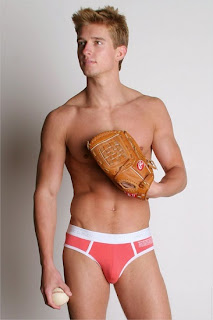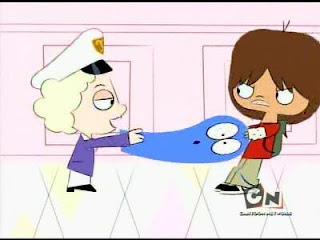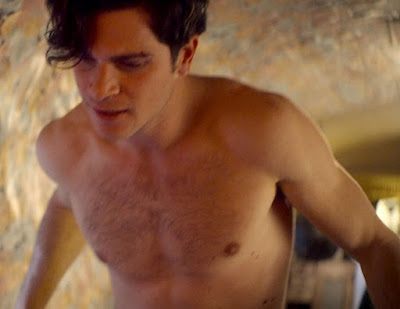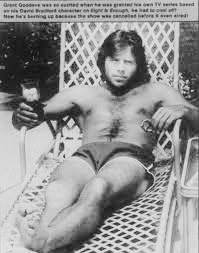Luna Park (2022) is set in Italy in the 1960s. The era of Antonini and Fellini, the sword-and-sandal epics, the spaghetti Westerns! I'm in.
Scene 1: An outdoor cafe. Close up of a girl's body, with a butterfly tattoo, unusual in the era. She steals a cute guy's wallet and then goes home to her trailer, where her grandmother criticizes her: "We're carnival folk. We don't steal." But at least Grandma agrees to let her run the fortune-telling booth tonight.
She tells Grandpa the good news about being allowed to do the fortune-telling. He shows her his new "magic camera," which develops photos instantly. It will be a hit at the carnival!
Scene 2: Luna Park is a carnival. A girl named Rosa and her brother Giggi (Guglielmo Poggi, top photo) have dates with two guys. Giggi keeps hitting on girls, but his boyfriend jealously pulls him away. They're probably not written as a gay couple, but the way they keep hanging on each other and going on rides together gives them a strong gay subtext ("Take me on the bumper cars!").
Carnival Girl talks Rosa into getting a tarot card reading. Her question: "Will I ever find my twin sister, who disappeared when we were kids? No one knows what happened. Dad even hired a private investigator; he's still paying, 20 years later." Let me guess: it's Carnival Girl. "She has a birthmark shaped like a butterfly on her back." Carnival Girl says "She's alive, and very close to you," but doesn't reveal her tattoo. Instead she gets upset and kicks Rosa out.
Scene 3: Rosa tells the guys that her sister is close by. They advise her to stop being so obsessed; fortune tellers say what you want to hear. Uh-oh, she dropped her wallet in the tent (or had it lifted). Giggi's boyfriend goes to retrieve it, and sees Carnival Girl's butterfly tattoo. They flirt, and tell their back stories: Carnival Girl has lived all over the world, and Boyfriend is an aspiring photojornalist.
Scene 4: Giggi and Rosa's Dad, a rich businessman, is wheeling and dealing in his palatial mansion.
Wait -- he's rich, but hiring a private investigator is a financial burden? Then he sits down to breakfast, and announces that he got Giggi an audition! Mom criticizes Dad for coddling him: let him get his own auditions!
I guess when you lose a kid, you get overprotective of the others. We get the names of the two boyfriends: Giggi has Simone (Alessio Lapice, left), and Rosa has Matteo.
Scene 5: Giggi and Simone waiting in line at the audition. The girl behind them introduces herself: she's right off the boat from Sardinia ("Toto, I don't think we're in Sardinia anymore.") Everyone gasps as superstar Sandro passes in the back seat of a convertible. He stops to ask Sardinian Girl out to dinner! There are 300 girls in that line. What does she have that's special?
Scene 6: The carnival family is working on a haunted house exhibit. Grandma complains that a skeletal Marilyn Monroe is in bad taste, since she just died (on August 4, 1962). A sketchy-looking guy wearing an earring comes in; everyone is shocked, and Grandpa hugs him. He's Grandpa's younger brother Ettore (Mario Sgueglia) visiting from Paris.
Younger brother? He looks like a grandson. He found an old home movie of Carnival Girl and her mother, so they all watch and get nostalgic. Carnival Girl sees the butterfly tattoo on her back, and wonders if she is Rosa's long-lost sister.
Scene 7: Giggi gives a terrible audition, goofing around when it's a dramatic role. But one of the directors offers him a job in television.
Switch to Rosa and her boyfriend Matteo playing tennis. She is still thinking about the "your sister is very close to you" line, and has made a list of prospects. Giggi and Simone drop by with the good news about the audition. Rosa and Matteo are sitting on opposite sides of the lunch table, but Giggi and Simone are pressed against each other. Lovers or not, don't they need some elbow room?
Scene 8: Superstar Sandro and Sardinian Girl arrive at the restaurant for their date. The papparazzi pounce. For some reason, Carnival Grandpa and Brother Ettore are there, complaining about superficiality and glitz. "I'm so glad Nora grew up in the carnival, where people are good and honest." I've never heard carnival workers described like that before. But at least we finally get Carnival Girl's name.
Switch to the carnival haunted house, with Carnival Girl Nora playing Marie Antoinette. She interrogates Grandma about her butterfly tattoo, but Grandma refuses any intel. Next she confides in her bff Celeste: "I'm not who I thought I was." Groan. Yet another best friend who is stuck in the friend zone with the Girl of His Dreams.
Scene 9: A huge book-lined office. Rosa asks her old college professor if she can borrow his Henry Miller book. Just buy your own copy. They have tea, and discuss... "You and Dad are bidding for the same property. I want you to bid, so you will build a place for people from the countryside to stay when they come to Rome." Like a youth hostel? Or a homeless shelter?
Scene 10: Aspiring photojournalist Simone's dark room. Rosa's boyfriend Matteo (Edoardo Coen, right) says that he's going to ask her to marry him tonight. "But...you haven't even kissed yet." "Yes, but I..."
Simone looks shocked. "What is the problem?" he asks. Afraid that Matteo is going to come out? Being gay would be quite a scandal in 1962. Matteo just says "Um...her...I want to wait for the right time."
Meanwhile, Younger Brother Ettore is introducing the carnival folk to his new friends; they all glare and snarl. The friends want him to audition for the movies, where acrobats make a lot more than in carnivals. They have other ideas, too. Shady ideas. Uh-oh.
Scene 11: Carnival Girl Nora sneaks into Grandma's trailer (she used to be the Fabulous Miranda). She doesn't find anything, and Grandma won't budge.
Scene 12: Rich Dad's fabulous birthday party. Giggi is hugging and holding his boyfriend Simone. Dad gets drunk and starts acting silly.
Matteo invites Rosa outside to make out, but loses his nerve. She has had enough: "Either make a move, or get out. Do you like me or not?" He proposes marriage, but that's not enough. "You have to kiss me!" He hesitates. "There's nothiing wrong with you, is there?" She means "Are you gay?" "Ok, ok, I'll...ugh, kissing girls is so disgusting....I'll do it."
They kiss. Simone and Giggi see them and congratulate Matteo on finally getting the job done. They provide champagne. To celebrate a first kiss? Well, Matteo is in his twenties, so they are probably celebrating "proof" that he's straight.
Scene 13: As the party devolves into seances and smoking, Rich Dad goes out onto the patio, gazes at the two couples, and gets depressed over the disappearance of his daughter Adele. "I couldn't save her." His friend: "Why don't you tell your family that she is dead?" "No; only you and I know the truth." Wait -- if Adele is dead, then who is Carnival Girl? And why won't he tell his family?
Scene 14: The next morning, Carnival Girl appears at the gate of the fabulous Villa Gabrielli. She sneaks Ain. The two couples from last night are asleep on lawn chairs (well, Rosa is reading her Henry Miller book). The end.
Beefcake: None.
Gay Characters: Maybe Matteo. Maybe Ettore, for that matter. I know Simone is going to hook up with Carnival Girl, but so help me, the actors playing Simone and Giggi are deliberately pushing a gay subtext.
Heterosexism: Not much. No one really expresses any heterosexual interest yet. I'm not even sure that Carnival Girl's Grandpa and Grandma are a married couple.
Plotlines: Five so far. Carnival Girl as the long-lost daughter; Simone's photojournalism career; Giggi's acting career; Dad and the Professor fighting over property; Matteo not being interested in girls.
My Grade: A if they keep the gay subtext going OR Matteo turns out to be canonically gay. Otherwise B.
Update: Giggi stays gay throughout: no interest in women after the first episode, lots of interest in men. He dumps Simone to become "best friends" with Superstar Sandro, who can't keep his hands to himself. There's even an "I was so drunk last night...." scene.
 In the early 1980s, I listened mostly to classical music. I was too old for teen idols, and adult music was dreadful, all about hetero-romance, hetero-sex, or large breasts. Especially when MTV began playing music videos to illustrate the songs.
In the early 1980s, I listened mostly to classical music. I was too old for teen idols, and adult music was dreadful, all about hetero-romance, hetero-sex, or large breasts. Especially when MTV began playing music videos to illustrate the songs.












































.jpg)
.jpg)